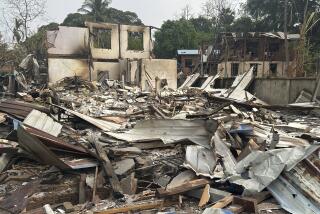Rebels Flee Into Jungle as Army Sweeps Island
- Share via
MANILA — Hundreds of heavily armed kidnappers holding 19 hostages, including an American and two French journalists, abandoned their camp Sunday and fled with their captives into the jungles of Jolo island after an all-out assault by the Philippine armed forces.
Defense Secretary Orlando Mercado said he believed that all the hostages were alive and unharmed.
“I would like to think they will not kill the hostages,” he told reporters, “because they know their own lives and livelihood depend on keeping them alive.”
With the government maintaining a news blackout on the operation--which Mercado said was intended to free the hostages and “neutralize” the rebel group known as the Abu Sayyaf--few details emerged. But fighting was apparently light as the army swept through the camp and pursued the kidnappers across steep jungled terrain.
The military struck the rebel camp with aerial bombing relentlessly after the invasion of Jolo island, 600 miles south of Manila, began at dawn Saturday. Gen. Angelo Reyes, the Philippines’ military chief, described the Abu Sayyaf as being in “escape mode.” But the guerrillas had no place to escape to as the Philippines tightened its naval blockade around the 345-square-mile island.
“Undeniably, the risk to the hostages’ lives remains very high,” Robert Aventajado, the government’s chief hostage negotiator, said. “You’re dealing with a big military operation and a large group of bandits under different leaders. What I hear from the military is that they’ll be very lucky if they are able to save the hostages’ lives.”
Aventajado said in an interview that the chance of resuming talks to win the hostages’ release is nil and that the government has disbanded the negotiating team.
“The military will definitely pursue its mission to the end,” he said, adding that President Joseph Estrada wants the kidnapping threat posed by the Abu Sayyaf permanently destroyed.
Although Aventajado has won the freedom of 31 hostages kidnapped by the rebels in various batches during the past six months, most of the 19 remaining captives are what he calls “walk-ins”--people who entered the Abu Sayyaf lair voluntarily for different reasons. Many paid the guerrillas an entrance fee to gain access to their camp.
The hostages are 12 Philippine Christian evangelists who trekked into the Muslim stronghold to pray for peace; French journalists Jean-Jacques Le Garrec and Roland Madura, who were covering the story of an earlier kidnapping; American Jeffrey Schilling, a Muslim from Oakland who entered the camp for unexplained reasons and is married to a cousin of a top rebel; three Malaysians; and a Philippine resort worker.
At one point, the rebel leader, Ghalib “Robot” Andang, complained to Aventajado that he had more hostages than he could handle. When the negotiator suggested that the Abu Sayyaf could lighten its burden by releasing some of them, Commander Robot, as he is called, replied: “What good would it do? They just keep on coming.”
But Andang also made sure his stable of captives was never empty because his group has collected an estimated $16 million in ransom in the past few months. After releasing four captives Sept. 9, the Abu Sayyaf went out the next day and snatched the three Malaysians from a nearby island and brought them to Jolo. Five days later, a frustrated Estrada broke off negotiations and ordered the attack.
Soldiers and marines pushing into the interior of Jolo are being backed by F-5 fighter jets and 105-millimeter howitzers. Helicopters continued to shuttle troops and equipment Sunday onto Jolo, an island with a population of 400,000, from the larger island of Mindanao. Military officials said the operation should take three to seven days.
Estrada’s decision to attack has been popular in this mostly Roman Catholic country where people are weary of decades of civil strife in the predominantly Muslim south, which Estrada visited Sunday in order to confer with his military commanders in the city of Zamboanga on Mindanao.
More to Read
Sign up for Essential California
The most important California stories and recommendations in your inbox every morning.
You may occasionally receive promotional content from the Los Angeles Times.










